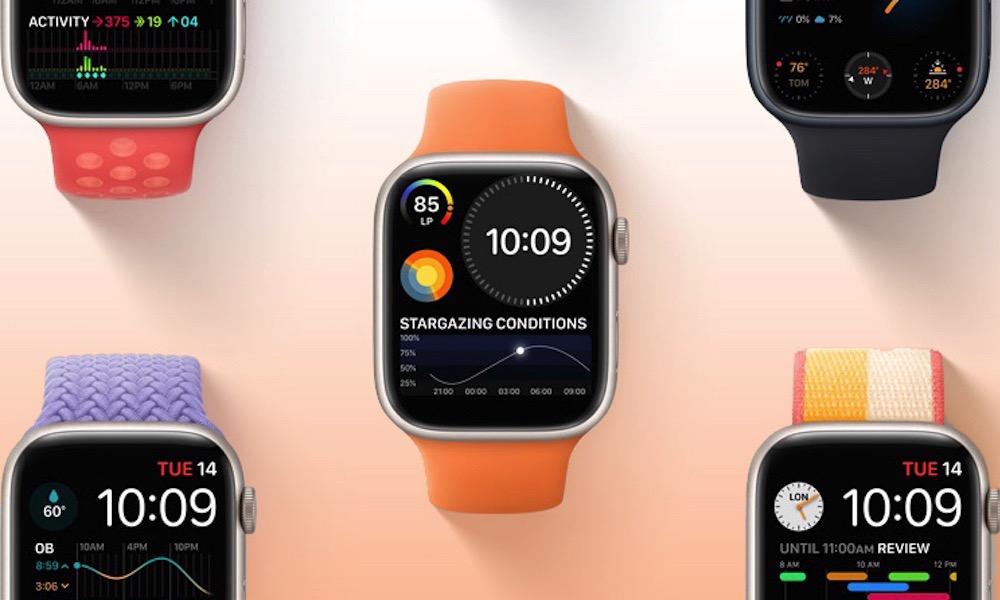The Apple Watch Series 7 Features a Mysterious New 60GHz Wireless Transceiver (But What’s It For?)
 Credit: Apple
Credit: Apple
Toggle Dark Mode
It appears that the new Apple Watch Series 7 may have one more trick up its sleeve in the form of a new wireless transceiver — an addition that has left many speculating on what Apple could be up to.
FCC filings for the new Apple Watch indicate that the wearable now transmits and receives data in the 60.5GHz frequency range — an order of magnitude above the sub-6GHz frequencies used for Wi-Fi, Bluetooth, and cellular data. Even Wi-Fi 6E, which the iPhone 13 was rumoured to gain (but didn’t), only uses the 6GHz band.
This higher frequency is even well above the range used by mmWave 5G, which has been allocated spectrum from 24.25GHz to 52.6GHz, although most carriers are only using 26GHz, 28GHz, and 39GHz at this point.
So, this quashes any theories that the Apple Watch could be gaining support for new Wi-Fi or 5G cellular technologies, although it’s fair to say that supporting mmWave on the Apple Watch would be absurd in the first place.
What 60GHz Wireless Could Be Used For
As with all wireless spectrum, higher frequencies offer faster speeds, but much shorter range. In fact, the 60GHz band was once used by the now largely defunct 802.11ad Wi-Fi standard, also known as WiGig. Routers like Netgear’s Nighthawk X10 could offer blazing fast speeds of up to 7.2Gbps with compatible 802.11ad devices, but only up to a range of about 30 feet.
Needless to say, the standard never took off, and it’s since been superseded by Wi-Fi 6, but the principle behind it was a sound one for devices needing high-speed communications at shorter ranges. In fact, it evolved into the 802.11ay standard, which focused on maximizing performance at ultra-short ranges, allowing it to hit speeds of up to 176Gbps.
Unfortunately, rumours last year that the iPhone 12 could gain 802.11ay never amounted to anything, and there’s been no evidence that it’s coming to the iPhone 13 this year either. The theory is that it could offer the high-speed data transfer required to power Apple’s future AR Headset, but now we wonder if the sources of those rumours actually misunderstood what Apple was doing.
There’s a clue in the FCC filings that suggests what Apple’s real purpose for the new transceiver is, and it looks like it’s probably intended exclusively for internal use by Apple support technicians:
A proprietary Wireless Serial Dock with a corresponding 60.5GHz module is needed to activate transmission on the Apple Watch. A magnetic alignment fixture locks the Apple Watch in place on top of the Wireless Serial Dock, thus allowing communication between the Dock and Apple Watch. The Wireless Serial Dock is powered by a USB-C port.
FCC Filings
It would appear that the transceiver in question is only active when the Apple Watch is placed on a special “proprietary Wireless Serial Dock.” Not only that, but the documents note that the dock also includes “corresponding 60.5GHz modules.”
In other words, it appears that this may be intended solely to allow authorized service technicians to troubleshoot the Apple Watch and possibly even reload its firmware directly — without relying on a wired connection.
The Apple Watch has always had a hidden diagnostic port under the watch strap, so it will be interesting to see if this year’s Apple Watch Series 7 eliminates that entirely in favour of this new wireless technology. Even if it’s still there, however, it could be intended merely as a fallback option.
While there’s no indication that Apple is using the 802.11ay standard here, the original 802.11ad standard demonstrated that wireless transfer speeds in the 60GHz frequency range could easily outpace most modern wired connections.
For example, consider that 802.11ad could deliver wireless speeds of up to 7.2Gbps at close range, whereas USB 3.0 caps out at 4.8Gbps. The newer USB 4 can reach 40Gbps, of course, but it would be a waste to put that into a diagnostic port to be used only occasionally by service technicians.
Leading the Way to the Future
Of course, once the 60GHz transceiver is there, there’s no reason Apple couldn’t employ it for other purposes, such as speeding up the connection between the iPhone and the Apple Watch. While there’s probably little practical reason to do this just yet — Wi-Fi 5 is more than adequate for what most people transfer to their wearable — it could open the door to new possibilities for Apple’s wearable.
Even the U1 chip in last year’s Apple Watch Series 6 has yet to be put to good use, so it’s clear that Apple is thinking ahead when it comes to the hardware technologies that it’s baking into its wearable, and this could also be more about Apple’s future ambitions than anything else. For instance, imagine an Apple Watch being able to control a new Apple AR/VR Headset in real-time, while also simultaneously maintaining a wireless connection with the user’s iPhone.
For now, however, perhaps what’s most significant is that it shows Apple’s willingness to move boldly into a fully wireless future. The Apple Watch has already been leading the way in that area, avoiding user-facing wired connections since the very first model in 2014. So, it makes sense for it to be the device that will take the next big step into helping us untangle ourselves.






